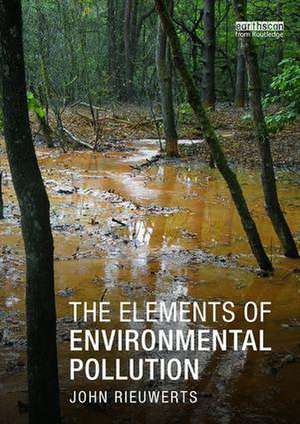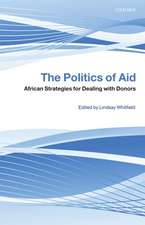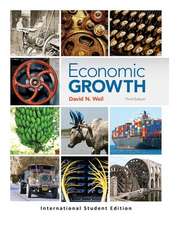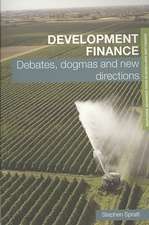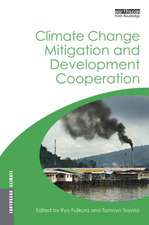The Elements of Environmental Pollution
Autor John Rieuwertsen Limba Engleză Paperback – 16 apr 2015
This textbook will support teaching and learning in environment-related university courses and will be vital reading for anyone with an interest in environmental protection.
| Toate formatele și edițiile | Preț | Express |
|---|---|---|
| Paperback (1) | 574.01 lei 6-8 săpt. | |
| Taylor & Francis – 16 apr 2015 | 574.01 lei 6-8 săpt. | |
| Hardback (1) | 1338.87 lei 6-8 săpt. | |
| Taylor & Francis – 27 apr 2015 | 1338.87 lei 6-8 săpt. |
Preț: 574.01 lei
Preț vechi: 675.31 lei
-15% Nou
Puncte Express: 861
Preț estimativ în valută:
109.83€ • 114.69$ • 90.70£
109.83€ • 114.69$ • 90.70£
Carte tipărită la comandă
Livrare economică 16-30 aprilie
Preluare comenzi: 021 569.72.76
Specificații
ISBN-13: 9780415859202
ISBN-10: 0415859204
Pagini: 352
Ilustrații: 230 black & white illustrations, 84 black & white tables
Dimensiuni: 174 x 246 x 20 mm
Greutate: 0.61 kg
Ediția:1
Editura: Taylor & Francis
Colecția Routledge
Locul publicării:Oxford, United Kingdom
ISBN-10: 0415859204
Pagini: 352
Ilustrații: 230 black & white illustrations, 84 black & white tables
Dimensiuni: 174 x 246 x 20 mm
Greutate: 0.61 kg
Ediția:1
Editura: Taylor & Francis
Colecția Routledge
Locul publicării:Oxford, United Kingdom
Public țintă
Postgraduate and UndergraduateCuprins
1. Pollution 2. Carbon (C) 3. Nitrogen (N) 4. Phosphorus (P) 5. Sulfur (S) 6. Arsenic (As) 7. Bromine (Br) 8. Cadmium (Cd) 9. Chlorine (Cl) 10. Chromium (Cr) 11. Copper (Cu) 12. Fluorine (F) 13. Lead (Pb) 14. Mercury (Hg) 15. Nickel (Ni) 16. Selenium (Se) 17. Tin (Sn) 18. Uranium (U) 19. Zinc (Zn) 20. Additional Environmental Pollutants
Recenzii
"The author writes clearly, targeting undergraduates who have some chemistry background. There is a good selection of end-of-chapter references, and most of them are from very recent research, mainly since 2000. This offers a very up-to-date viewpoint of the subject. The book also provides an unusually useful selection of figures and tables. Summing Up: Recommended. Undergraduate and graduate students."
CHOICE, H. E. Pence, SUNY College at Oneonta
"This is an excellent primer that provides a refreshing approach to understanding contemporary pollution issues. It provides a useful systematic approach to examining the role of key elements that chiefly affect human and environmental health; combining their chemistry with relevant environmental processes. This is a very useful text book which should be on hand to all Environmental Science, Chemistry and Geography students."
Crispin Halsall, Lancaster University, UK
"As our generation contemplates conditions being created for future generations, the topic of anthropogenic pollution of air, waters and soils will need to be closely evaluated and considered in order to protect and preserve the Earth's lifeforms, including humans. This book is an important extension of the literature on the role of human activities in changing the environment of the Earth and the topic is handled exceptionally well."
Howard W. Mielke, Tulane University, USA
"I am very impressed by this book. It is clearly written, accurate and places pollution in its correct context. The book fulfils an important need and it is comprehensive and readable."
J.N.B. Bell, Imperial College London, UK
"This book offers a fresh look at the interaction between the building blocks of our planet and human activities. Travelling through the periodic table, it examines the way we affect and may disrupt the life cycles of the most important and abundant elements necessary for life, and as a result influence our health and the health of the ecosystem around us. It is written in an accessible style whilst at the same time is underpinned by clear scientific principles."
Hemda Garelick, Middlesex University, UK
"A highly readable text that is both interesting and informative. I recommend this book as a valuable resource for undergraduates undertaking modules in environmental pollution and, more broadly, as background reading for students taking environmental degrees."
Peter J Shaw, University of Southampton, UK
"Identifying and comprehending the phenomenon of pollution requires that we understand the difference between natural material fluxes and those caused by mankind. This book, which classifies pollution processes according to individual elements, should be part of the library of all those concerned with environmental geochemistry and pollution."
Martin Mihaljevič, Charles University, Czech Republic
"The simple, fluent writing style makes this an extremely accessible book, especially for readers without a firm background in chemistry. Complex concepts are explained clearly, with additional background information provided for non-specialists."
Royal Society of Chemistry- Environmental Chemistry Group
CHOICE, H. E. Pence, SUNY College at Oneonta
"This is an excellent primer that provides a refreshing approach to understanding contemporary pollution issues. It provides a useful systematic approach to examining the role of key elements that chiefly affect human and environmental health; combining their chemistry with relevant environmental processes. This is a very useful text book which should be on hand to all Environmental Science, Chemistry and Geography students."
Crispin Halsall, Lancaster University, UK
"As our generation contemplates conditions being created for future generations, the topic of anthropogenic pollution of air, waters and soils will need to be closely evaluated and considered in order to protect and preserve the Earth's lifeforms, including humans. This book is an important extension of the literature on the role of human activities in changing the environment of the Earth and the topic is handled exceptionally well."
Howard W. Mielke, Tulane University, USA
"I am very impressed by this book. It is clearly written, accurate and places pollution in its correct context. The book fulfils an important need and it is comprehensive and readable."
J.N.B. Bell, Imperial College London, UK
"This book offers a fresh look at the interaction between the building blocks of our planet and human activities. Travelling through the periodic table, it examines the way we affect and may disrupt the life cycles of the most important and abundant elements necessary for life, and as a result influence our health and the health of the ecosystem around us. It is written in an accessible style whilst at the same time is underpinned by clear scientific principles."
Hemda Garelick, Middlesex University, UK
"A highly readable text that is both interesting and informative. I recommend this book as a valuable resource for undergraduates undertaking modules in environmental pollution and, more broadly, as background reading for students taking environmental degrees."
Peter J Shaw, University of Southampton, UK
"Identifying and comprehending the phenomenon of pollution requires that we understand the difference between natural material fluxes and those caused by mankind. This book, which classifies pollution processes according to individual elements, should be part of the library of all those concerned with environmental geochemistry and pollution."
Martin Mihaljevič, Charles University, Czech Republic
"The simple, fluent writing style makes this an extremely accessible book, especially for readers without a firm background in chemistry. Complex concepts are explained clearly, with additional background information provided for non-specialists."
Royal Society of Chemistry- Environmental Chemistry Group
Descriere
The Elements of Environmental Pollution provides a clear and user-friendly text that clearly explains the nature and extent of environmental pollution and provides the necessary scientific background in environmental chemistry and biogeochemistry. The book illustrates how local and global pollution problems arise from human activity disturbing natural elemental cycles and our introduction of hazardous materials into the natural world. A key feature of the book is its structural focus on individual elements, their natural and anthropogenic pathways around the earth system and the real world consequences of this dynamic flow. This clearly written and comprehensive text contains a wealth of features to assist student learning, including end of chapter summaries and questions, suggestions for further reading and relevant websites, as well as its own companion website providing additional instructor and student resources.
